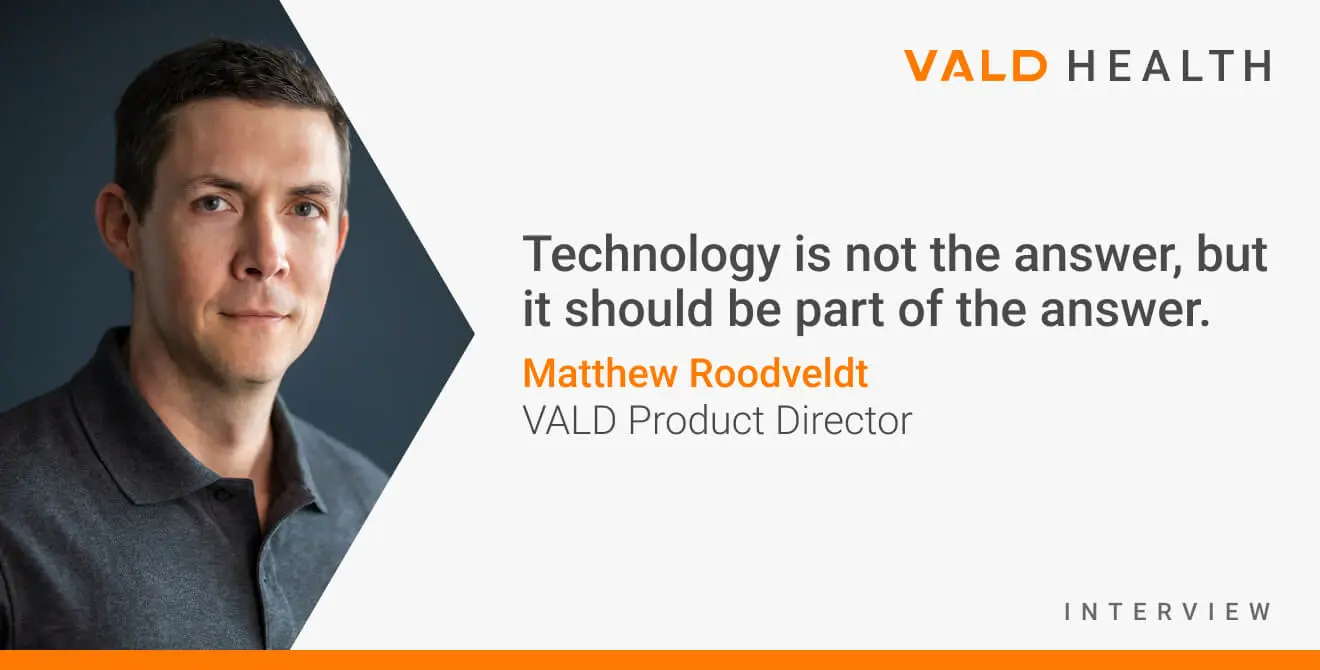Technology is not the answer, but it should be part of the answer
Available in:
EN
When clinics are looking to invest in technology, the question Matthew Roodveldt, Product Director at VALD Health, gets asked is: “Will technology bring in more clients and make my clinic more profitable?” His answer: “Good question, the answer is no, not alone; however, it can be part of a holistic approach.”
Human measurement systems can be a powerful tool in helping clinicians make decisions based on objective data as well as an opportunity to engage and empower clients with their rehabilitation or performance assessment and training programs. With that said, implementing new technology systems can be challenging for many clinics.
It’s a common misconception that this technology is only affordable and useful for elite sporting teams or research centres, universities and hospitals, but Matthew Roodveldt Product Director at VALD Health says they are experiencing increasing demand from private practices for this technology.
Clinicians have been collecting data via manual tests for decades. What are the benefits of using human measurement technologies?
In the past, assessing strength and power has been subjectively quantified by using manual tests of resistance and functional movement tests such as squatting or jumping. Other clinicians can replicate this type of data collection, but the reliability between clinicians is blurred. With human measurement technologies, data can be captured objectively and transferred from clinician to clinician.
With a vast scope of metrics which can be captured. How do clinicians know what meaningful data is?
From our background in providing technology to elite sports professionals, we know from research that certain metrics can assist clinicians in making decisions around injury risk reduction and programs to improve strength and power. In a general population setting, while we still have the same injuries that athletes sustain, we have less normative data to work with, and decisions are made based on what’s normal for the individual. Therefore we use exercise protocols to guide clinicians in completing tests to ensure they are reliable and repeatable.
Not all metrics will suit your situation, so pick what works for you in your environment. When choosing tests to perform, consider the individual’s needs and the measurements which will help you monitor progress.
No technology out-of-the-box will make your clinic more profitable.
How can a clinic owner ensure they are getting ROI from technology?
One of the most significant barriers in clinics adopting new technology is the perceived cost and unknown value. I have heard of countless technology systems claiming objective data is the way of the future and will make your clinic more profitable and engage your clients. Still, I can honestly say, no technology out-of-the-box will make your clinic more profitable.
We work with many clinics to implement our human measurement systems and ensure they are getting value from their investment. This is achieved by much more than the data and reports. Data is only one piece of the puzzle in the retention of clients, access to new clients, a competitive advantage, and a broader scope of services and packages.
First and foremost, data is the bridge of communication between client, clinician and other providers. If a client returns for similar treatment, you will have objective data on hand that can be used to quantify further recovery, similarly if they see another provider.
Collecting quantitative data will allow you to compare against existing norms and help to create a personalised recovery plan for your clients. This also offers a competitive advantage; you will have a unique offering that you can add to your services and packages. Some savvy clinics offer initial data collection complimentary at their local sporting clubs and gyms. Once you have an individual’s benchmark data, you are the only practitioner who can help them get back to what their ‘normal’ is post-injury.
Engaging clients through data will help to promote buy-in and build rapport. Data can enhance the client experience in three key ways. Data visualisation can assist in educating clients and get their buy-in. It can be tough for a client to see their progress through subjective analysis or numbers alone. With the use of visuals, clients can see how they have improved throughout their experience. We know from past research that people may be at higher risk of sustaining injuries when they are below recommended values. By using data, we help to educate clients and set small achievable targets along their recovery journey. Setting goals for long term rehab makes it more attainable for your client to see the light at the end of the tunnel and understand the work they need to do to reach full recovery.
Lastly, data reports can help to keep the client informed of their progress (while also allowing for quick reference points for clinicians) and help to keep additional members of an allied health team informed of a client’s progress.
Do I need to be a data scientist or sport scientist to interpret data?
While a small amount of relevant knowledge is needed to understand particular metrics (such as hip adduction strength), you don’t need to have a data or sport scientist readily available to help interpret the data. Data visuals help to collate and simplify the information, allowing for quick and easy understanding for the practitioner and the client.
Matthew’s 5 tips for implementing new technology
- Do your research, choose a provider that aligns with your business
- Achieve buy-in of stakeholders
- Map out a plan for adoption
- Build the right team for the job
- Continue the communication with your provider and team
Originally posted in Allied Magazine Issue 18, August 2020. Written by Matthew Roodveldt.
Matthew Roodveldt is Product Director at VALD Health. Matthew has an undergraduate degree in human movement and worked in research for human movement studies and physiotherapy. Following this, Matthew has spent the last ten years managing a software development group and is combining this experience with an in-depth understanding of the needs of the healthcare market.
